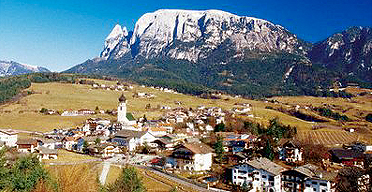
The titanic peaks and crags of the Dolomites and the trails that snake their way up them - known as vie ferrate- are not for anyone suffering from vertigo. But if you have a head for heights and you like tremendous views, then you'd be hard pressed to find more dramatic mountain walking and scrambling anywhere on the planet.
The singular via ferrata translates as "iron way", which refers to the iron rungs and ladders and steel hawsers that provide "protection" on these airy mountain scrambles and climbs. Clipped on to the hawser via a carabiner, short length of rope and climbing harness, the vie ferrate allow you to enjoy the kind of drama and exposure that is normally reserved only for experienced mountaineers and climbers - it's not at all unusual to find yourself clinging to a narrow rock shelf or a series of iron rungs with a drop of several hundred metres beneath your feet, while all around are inspirational views of the surrounding mountains and glaciers.
Best of all, almost anyone who enjoys walking in the mountains can also enjoy a clamber on a via ferrata. They're graded from "A" (which any adventurous 10-year-old will cope with) to "G" (good climbing skills necessary). Beginners with a head for heights should be able to cope with the route I followed on my first day in the Dolomites, the 440m grade "D" Via Ferrata Brigata Tridentina on the Sella massif above the town of Corvara.
The first via ferrata to be constructed in the Dolomites was the Possnecker path, which snakes up the same massif, and dates back to the early 1900s. Many of the early vie ferrate were constructed between 1915 and 1917 when Italian and Austrian troops fought each other in the Dolomites and built the paths to assist with movements of troops and equipment.
Two experienced British climbers we met on our trip were not afraid to admit that they'd had a "bit of an epic" negotiating a wartime path on the 2,733m Bec de Mesdi. Mind you, they were also dealing with rain, sleet and snow - in early September. This was one of the harder vie ferrate, graded "F", but it illustrates that for all their relative ease and security, these trails still need to be treated with the respect due to any high-mountain activity.
For the Brigata Tridentina climb, I had a guide because it was years since I did any "real" climbing, but experienced climbers shouldn't need to go to this expense as the routes are simple to follow - just look out for all the metalware up the cliff face. And since this was one of the most popular vie ferrate in the Dolomites, the line of people preparing to climb at the bottom of the crag was something of a giveaway to the route's location.
The weight of people on the more popular routes can detract a little from the mountain experience, although outside July and August numbers are considerably lower. And when you have views like we did, with the Val di Corvara opening out hundreds of metres below, the massive tower of 2,625m Sasshonger Peak looming across from the opposite side of the valley and a small waterfall hissing away on our left flank, you soon forget about anyone else clanking up the mountain behind you.
But not all the routes are cluttered with clambering climbers. The following day, I climbed the 240m via ferrata to the summit of 2,908m Piz da Lec, towering over Corvara, with not another soul in sight. Easily reached via two ski lifts from the town, you can do this route in a morning and spend the rest of the day on the summit eating your picnic and looking across a superb alpine panorama that stretches all the way to Austria. The vista takes in the high, desert-like hanging valley of the Val de Mesdi and, off to the south east, the ice-blue folds of the Marmolada glacier.
If you get hooked on the alpine life, you can explore the hills further by using a combination of footpaths and vie ferrate to follow long distance routes through the mountains. Refuges equipped with bunks and serving meals mean that all you have to carry are spare clothes and a sleeping bag. In theory, you could wander the mountains all summer.
Way to go
Getting there: Inghams Lakes & Mountains (020-8780 4433, inghams.co.uk) has a wide choice of package deals in the Italian Dolomites. Seven nights' half-board at the three-star Hotel Linder in Selva, costs from £512pp including Gatwick-Verona flights and transfers.
Mountain refuges cost €16 per night, €8 if you're a member of a recognised climbing club.
Equipment: You'll need all the gear you'd take for a day out on the British hills, plus a climbing harness, about 3½m of 11mm rope, two special via ferrata self-locking carabiners with rope blocks, a kinetic impact shock absorber and a climbing helmet. Local climbing shops sell the full rig (apart from the helmet) for around €70.
Recommended reading: Via Ferrata - Scrambles In The Dolomites, translated by Cecil Warner (Cicerone, £12.99).
Further information:
Corvara Tourist Information Office, Str Col Alt 36 (+471 836 176, altabadia.org). Italian Tourist Board (020-7408 1254, enit.it).
Country code: 00 39.
Flight time Gatwick-Verona: 2hrs.
Time difference: +1hr.
£1= 1.40 euros.

